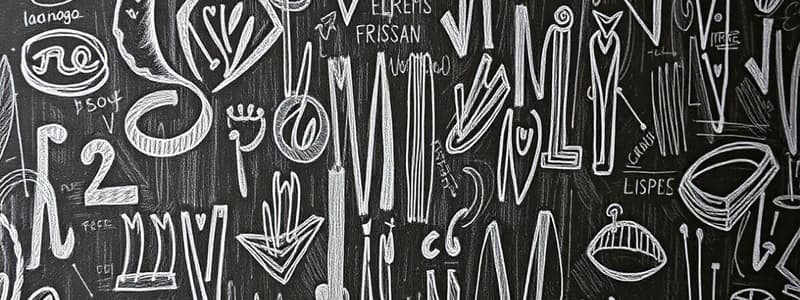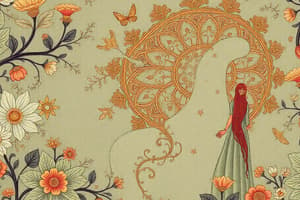Podcast
Questions and Answers
A society experiences a sudden surge in technological innovation, leading to widespread adoption of new communication tools and automation in various industries. Which type of factor is primarily influencing this cultural change?
A society experiences a sudden surge in technological innovation, leading to widespread adoption of new communication tools and automation in various industries. Which type of factor is primarily influencing this cultural change?
- Acculturation
- External Factor (correct)
- Internal Factor
- Cultural Lag
A long-isolated community begins trading with a nearby city. Over time, the community starts adopting the city's currency, fashion, and social customs, while also maintaining some of its own traditions. Which cultural process is most evident in this scenario?
A long-isolated community begins trading with a nearby city. Over time, the community starts adopting the city's currency, fashion, and social customs, while also maintaining some of its own traditions. Which cultural process is most evident in this scenario?
- Cultural Relativism
- Cultural Diffusion
- Acculturation (correct)
- Cultural Assimilation
A country with a traditionally collectivist culture experiences increased exposure to individualistic cultures through widespread internet access and global media. What is the most likely long-term impact on the country's cultural values?
A country with a traditionally collectivist culture experiences increased exposure to individualistic cultures through widespread internet access and global media. What is the most likely long-term impact on the country's cultural values?
- A hybrid cultural identity that incorporates elements of both collectivism and individualism. (correct)
- Increased social cohesion and conformity to traditional norms to protect the culture.
- Complete shift to individualistic values, abandoning all traditional practices.
- Reinforcement of traditional collectivist values due to resistance to external influences.
A researcher is studying a society where public displays of emotion are considered inappropriate. What type of approach should the researcher adopt to avoid misunderstandings and biases when interpreting the society's communication style?
A researcher is studying a society where public displays of emotion are considered inappropriate. What type of approach should the researcher adopt to avoid misunderstandings and biases when interpreting the society's communication style?
Which of the following scenarios best illustrates the impact of internal conflict on cultural change?
Which of the following scenarios best illustrates the impact of internal conflict on cultural change?
Which of the following best describes the role of language in cultural transmission?
Which of the following best describes the role of language in cultural transmission?
How do norms typically influence behavior within a culture?
How do norms typically influence behavior within a culture?
In what way does socialization contribute to cultural transmission?
In what way does socialization contribute to cultural transmission?
What does the existence of subcultures within a larger culture primarily indicate?
What does the existence of subcultures within a larger culture primarily indicate?
If a country rapidly adopts technological advancements from another, significantly altering its daily routines and communication methods, which aspect of culture is most directly affected?
If a country rapidly adopts technological advancements from another, significantly altering its daily routines and communication methods, which aspect of culture is most directly affected?
How do cultural beliefs impact societal practices?
How do cultural beliefs impact societal practices?
Consider a society where individual success is highly valued. How might this cultural value manifest in their educational system?
Consider a society where individual success is highly valued. How might this cultural value manifest in their educational system?
Imagine a society transitioning from valuing communal harmony to emphasizing individual expression. What changes might be observed in their cultural symbols?
Imagine a society transitioning from valuing communal harmony to emphasizing individual expression. What changes might be observed in their cultural symbols?
Flashcards
Cultural Change
Cultural Change
Culture constantly evolves due to internal and external forces.
External Factors
External Factors
Events like technology and migration that impact cultural norms.
Internal Factors
Internal Factors
Innovations or conflicts within society that shift cultural values.
Acculturation
Acculturation
Signup and view all the flashcards
Importance of Studying Culture
Importance of Studying Culture
Signup and view all the flashcards
Culture
Culture
Signup and view all the flashcards
Symbols
Symbols
Signup and view all the flashcards
Language
Language
Signup and view all the flashcards
Values
Values
Signup and view all the flashcards
Norms
Norms
Signup and view all the flashcards
Beliefs
Beliefs
Signup and view all the flashcards
Cultural Transmission
Cultural Transmission
Signup and view all the flashcards
Subcultures
Subcultures
Signup and view all the flashcards
Study Notes
Key Elements of Culture
- Culture encompasses shared beliefs, values, customs, behaviors, and artifacts that characterize a social group or society. It's a complex system shaping how individuals perceive and interact with the world.
Components of Culture
-
Symbols: Objects, gestures, or language carrying specific meanings within a culture, like flags, religious icons, and handshakes.
-
Language: A central element enabling communication and cultural knowledge transmission across generations. Language structure and vocabulary reflect cultural values and perspectives.
-
Values: Deeply held beliefs about good/bad, right/wrong, desirable/undesirable, dictating behavior and decision-making within a culture. Examples include individual achievement, collectivism, and respect for elders.
-
Norms: Rules or standards of acceptable behavior, varying widely from social etiquette to moral codes.
-
Beliefs: Convictions or assumptions about the world, often religious or philosophical, shaping worldviews. Beliefs influence rituals and customs.
Cultural Transmission
-
Culture evolves and is passed down through generations.
-
Socialization: Individuals learn and internalize cultural norms and values via families, communities, and institutions.
-
Learning: Observing, imitating, and participating in cultural practices helps individuals function effectively within society.
Cultural Variation
-
Cultures differ across regions and groups, reflecting diverse historical experiences, environmental factors, and social structures.
-
Diversity: Recognizing and appreciating cultural diversity promotes understanding and reduces conflict. Differences can vary from daily routines to religious beliefs and social norms.
-
Subcultures: Distinct subgroups within a larger culture, with unique values, beliefs, and behaviors based on ethnicity, religion, age, etc.
Cultural Change
-
Culture is dynamic, changing due to internal and external forces.
-
External Factors: Technological advancements, migration, contact with other cultures significantly alter existing norms.
-
Internal Factors: Innovations, discoveries, and conflicts within a society can shift values and traditions. Changes occur over varying periods.
-
Acculturation: Cultural exchange and adoption of traits from another culture leads to adaptation and assimilation.
Importance of Studying Culture
-
Studying culture is crucial for understanding the diversity of human experience.
-
Recognizing cultural context is essential for effective communication and cooperation across groups.
-
Recognizing cultural biases helps prevent misunderstandings and conflict.
Studying That Suits You
Use AI to generate personalized quizzes and flashcards to suit your learning preferences.




